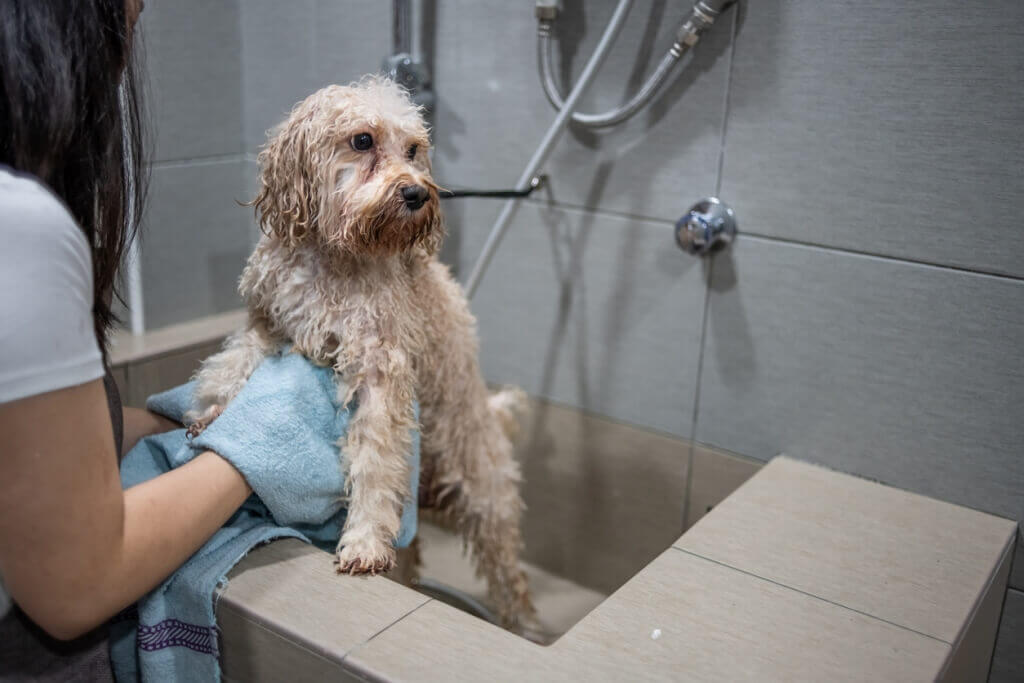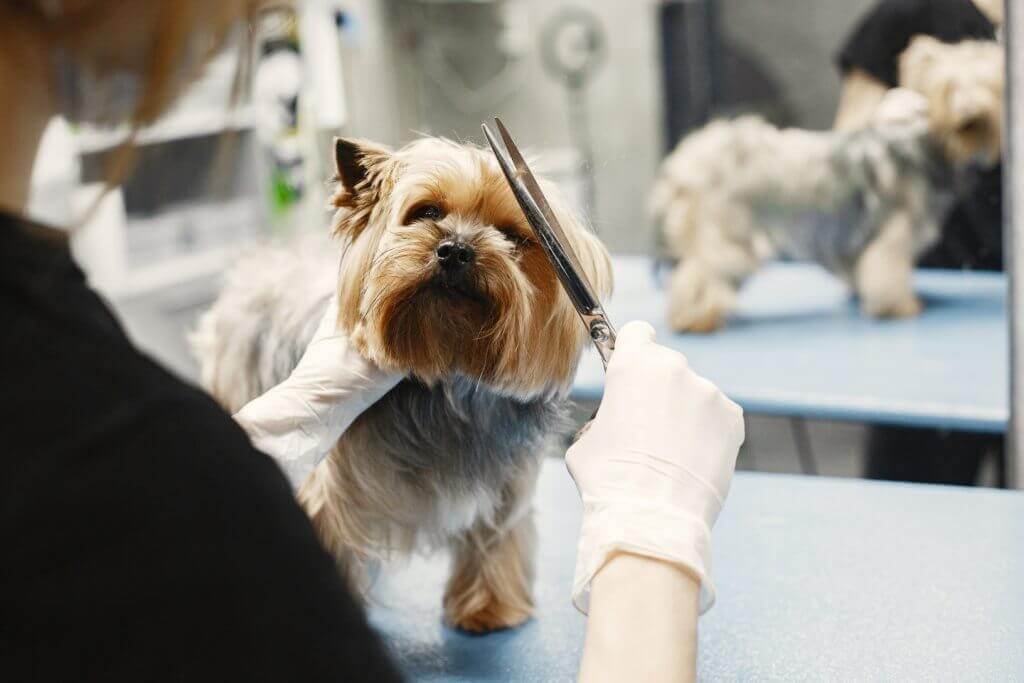Dog grooming sessions are crucial to preserving a dog’s general health and well-being; they are not merely for aesthetic purposes. Grooming is essential for giving pets the care they need, from fostering healthy skin and coats to preventing common health problems.
This article provides a comprehensive guide to dog grooming sessions, covering what is included in a grooming session, step-by-step instructions on performing each task, and potential career opportunities.
Whether you are a dog owner aiming to improve your pet’s well-being or someone interested in a career in dog grooming, this article will provide valuable insights and guidance. Let’s explore the world of Dog grooming sessions and their significance in keeping our furry friends happy and healthy
Table of Contents
ToggleI. What is Included in dog Grooming session
A. Bathing and Drying

Regular bathing is the first and foremost part of a dog grooming session. It is essential to maintain a clean and healthy coat for dogs. It involves using dog-friendly shampoos and conditioners to remove dirt, allergens, and parasites from the coat.
Additionally, proper rinsing and drying techniques ensure the dog’s skin is thoroughly clean and free from irritation
B. Brushing and Combing

Dog grooming sessions must include regular brushing and combing. They are essential for avoiding matting, getting rid of stray hair, and fostering a healthy coat.
Moreover, different coat types require specific brushes or combs to remove tangles and distribute natural oils effectively. Furthermore, brushing the skin stimulates it, encourages blood flow, and enables the early identification of skin-related issues or irregularities.
C. Coat Trimming and Styling

Coat trimming and styling involve maintaining a dog’s coat’s desired length and appearance. This procedure differs depending on the breed and the individual. It may include scissoring, clipping, or hand-stripping techniques to shape the skin, remove excess hair, and enhance the dog’s overall aesthetic appeal.
D. Nail Trimming and Paw Care

Dog grooming sessions include nail trimming, crucial for a dog’s comfort and overall foot health. Overgrown nails can make walking painful, uncomfortable, and difficult.
Proper paw care also involves regular examination for debris or injuries, moisturizing paw pads to prevent cracking, and ensuring the paw is free from infections or sores.
E. Ear Cleaning and Dental Care

The most important aspects of dog grooming sessions are routine ear cleaning and dental treatment to avoid infections and maintain excellent oral health. Furthermore, ear cleaning involves veterinarian-recommended solutions and gentle techniques to remove excess wax and debris from the ears.
Dental care includes giving the dog dental chews or toys, brushing their teeth with toothpaste safe for dogs, and, if needed, making appointments for expert dental cleanings.
F. Anal Gland Expression
Last but not least, a dog grooming session involves anal gland expression. It empties the anal glands to prevent discomfort and potential issues. Groomers or veterinarians perform this procedure when the glands do not naturally empty. It can lead to blockage or infection.
A regular expression can help prevent anal gland problems, such as impaction or abscesses, and maintain a healthy digestive system.
II. How to Do Grooming
A. Preparing for a Dog Grooming Session
a) Gathering Necessary Grooming Supplies
Gather essential supplies such as dog-friendly shampoos, conditioners, brushes, combs, nail clippers, ear-cleaning solutions, and towels to ensure a successful grooming session.
Additionally, have the appropriate grooming tools ready, including grooming shears, clippers, and a table or non-slip mat. All the necessary supplies will make the grooming process smoother and more efficient.
b) Creating a Calm and Comfortable Environment
Make a peaceful, welcoming area for your dog’s grooming. Choose a well-lit, ventilated space with non-slip flooring. Place treats, toys, and a familiar blanket or mat to help your dog feel relaxed.
Furthermore, consider playing soothing music to create a calming atmosphere. Lastly, the environment is crucial in reducing your dog’s anxiety. It can make the grooming experience more pleasant for both of you.
B. Step-by-Step Guide to a dog grooming session
a) Brushing and Combing the Coat
To begin, brush your dog’s coat to get rid of mats, knots, and loose hair. Make use of the proper brush or comb for the coat type. For dogs with longer coats, use slicker brushes or pin brushes. For shorter coats, use bristle brushes or grooming gloves.
Focus on delicate areas like the belly and the areas behind the ears when softly brushing in the direction of hair development. Regular brushing stimulates the skin, encourages blood flow, and maintains a healthy and shiny coat.
b) Bathing and Drying the Dog
Prepare warm water in a tub or use a handheld shower head. Thoroughly wet your dog’s coat, avoiding the head and ears. Apply a dog-friendly shampoo and gently massage it into the skin, paying special attention to the neck, back, and underbelly since these are areas that frequently become oily or unclean.
Afterward, rinse the coat thoroughly to remove all shampoo residue. To fully dry your dog, towel-dry him or use a low setting on a pet dryer. Additionally, be cautious with the dryer’s heat to avoid causing discomfort or drying out the skin.
c) Trimming the Coat and Styling
Trimming is necessary for dogs with long or dense coats to maintain a neat appearance. Hence, use grooming shears or clippers with appropriate attachments to trim the fur to the desired length. Furthermore, be cautious around sensitive areas like the face, ears, and paws.
Use blunt-tipped scissors for safety. Follow breed-specific or preferred styling techniques to achieve the desired look. Lastly, consult a professional groomer for guidance if you need clarification on specific styling.
d) Nail Trimming and Paw Care
To begin with, hold your dog’s paw carefully and trim the nails, being cautious not to cut into the quick, delicate area with blood vessels. After that, use a sharp, dog-specific nail clipper and make minor, gradual cuts.
If your dog has dark nails, trim them gradually to prevent cutting them too rapidly. Moreover, seek a professional groomer or veterinarian guidance for more clarification about nail trimming. Additionally, regularly inspect and clean the paws, removing debris and applying a paw balm for miniaturization.
e) Cleaning the Ears and Maintaining Dental Hygiene
To clean your dog’s ears during a grooming session, use cotton balls and an ear-cleaning solution that has been prescribed by a veterinarian. Be careful not to insert anything too deeply into the ear canal to prevent injury. Remove any extra wax or dirt from the outer ear by wiping.
Furthermore, if you notice any redness, swelling, or an unusual odor, consult a veterinarian, as it may indicate an ear infection.
For dental hygiene, introduce tooth brushing using dog-specific toothpaste and toothbrush. First, start by gently lifting your dog’s lips and brushing the outer surfaces of the teeth in small circular motions.
Gradually accustom your dog to the process, starting with short brushing sessions and rewarding it with praise and treats. Regular dental care helps avoid several dental problems.
f) Expressing Anal Glands (If Necessary)
Lastly, in a dog grooming session, anal gland expression should only be done by a professional groomer or veterinarian if necessary. Some dogs may require assistance expressing their anal glands, especially if they experience discomfort or recurrent issues.
Moreover, scooting, excessive licking of the anal region, or a bad odor are indications that the anal glands may need to be expressed. To prevent harm or infection, it is imperative to seek professional advice.
III. Dog Grooming Session Tips And Considerations
- Handle sensitive areas with care: When grooming sensitive areas such as the face, ears, and paws, use gentle techniques and approach them with patience and reassurance.
- Control stress associated with grooming: When grooming your dog, keep sessions brief and encouraging and gradually lengthen them as your dog grows more at ease. Reward your dog with praise throughout the process.
- Establish a dog grooming session routine: Regular grooming sessions help maintain your dog’s coat and overall hygiene effectively. Set a grooming schedule that works for you and your dog, ensuring consistency and regularity.
IV. Career in Dog Grooming
If you have a passion for dogs and a desire to work closely with them, pursuing a career in dog grooming sessions can be a fulfilling and rewarding choice. Additionally, learning dog grooming allows you to provide essential dog care and opens up a world of opportunities in the pet industry.
The Dog grooming profession’s scope is vast, with a growing demand for skilled and knowledgeable groomers. Therefore as a dog groomer, you can work in various settings, including grooming salons, veterinary clinics, and pet spas, and even start your own business.
The pet industry is experiencing steady growth since pet owners increasingly seek professional dog grooming sessions to ensure their furry friends are well-groomed and healthy.
To embark on a journey in dog grooming, it is beneficial to seek formal education and training. Numerous vocational schools, academies, and training programs offer comprehensive courses in dog grooming sessions.
These programs cover essential topics such as breed-specific grooming techniques, handling different coat types, understanding dog behavior, and business management skills.
As you gain knowledge and experience, you can specialize in specific areas of grooming, such as show grooming, creative grooming, or even working with certain breeds. Continuous learning is vital in this profession, as staying updated with dog grooming sessions, techniques, and products will help you provide the best care for your furry clients.
A dog grooming career allows you to work with dogs daily and provides an opportunity to connect with pet owners and positively impact the lives of their beloved companions.
It is a profession filled with love, satisfaction, and the joy of seeing dogs transformed into their best selves. So, if you have a genuine love for dogs and a passion for grooming, consider exploring the exciting and fulfilling world of dog grooming.
V. Conclusion
In conclusion, a dog grooming session is about maintaining a dog’s physical appearance and is a crucial aspect of its overall health and well-being. Throughout this article, we have explored the various components of dog grooming sessions, from bathing and brushing to coat trimming and dental care.
We have made a point of emphasizing the value of routine grooming in preventing skin conditions, matting, and other health issues.
As responsible dog owners, we must prioritize and invest in regular grooming sessions for our beloved pets. Additionally, we have discussed the potential career opportunities in dog grooming, highlighting the importance of professional groomers in providing specialized care.
Therefore, by understanding the importance of grooming and its impact on our furry companions, we can ensure they lead happy, healthy lives. So, let’s embrace the art of dog grooming and create a beautiful bond with our dogs, keeping them healthy, clean, and content.
Check the related topic: Why dog licks after grooming?

